
Published: August, 1962
Script: Stan Lee
Art: Steve Ditko
Letters: Art Simek
The Spider-Man origin story. What a classic! I bet there are a ton of people who have never read a single page of a Marvel comic, yet are at least somewhat familiar with the Spider-Man origin story. A lot of that, of course, would be due to the rash of Spider-Man movies that have come out during the last decade or so, and now I hear we are getting ready to “reload” Spider-Man, with a new movie this summer. And there’s also a Broadway show about Spider-Man! Not to mention that Spider-Man has been a fixture in cartoons almost continuously since 1967. And I guarantee that if you were to visit any toy store anywhere in these United States, you would find some representation of Spider-Man on those shelves, fully fifty years after Peter Parker first concocted his homemade “spider webs” with liquid cement to propel himself through the skyline of New York City.
Really now: can this guy be any more popular?
COSTUMES
Stan starts out on the first page of this first Spider-Man story by saying that “we in the comic mag business” refer to “costume heroes” as “Long underwear characters.” I guess that was supposed to be a joke? As if “costume heroes” is not funny enough on its own? I always get a chuckle when the Marvel characters refer to “costumes.” I’m thinking…wouldn’t “Disguised” or “Incognito” have been a better, more to-be-taken-seriously description? When I hear the word “costume,” sorry, but the first thing I think is “Trick or Treat!” You know they say the definition of an intellectual is someone who can hear the William Tell Overture without thinking of The Lone Ranger. Well, I might have to be reading comic books a very long time before I can hear the word “costume” and not wonder where the Halloween party is going to be.
But anyway… let’s get back to Spider-Man!
1960’S SENSIBILITIES
On the first page we see a group of teenagers engaged in what we would today call “dissing” Peter Parker. They laugh at the thought of him going to the dance, because he is the high school’s only “professional wallflower.” And one fella, who I believe is supposed to be Flash Thompson (who we will later discover is Peter’s high school nemesis) provides what is apparently the ultimate insult by proclaiming “That bookworm wouldn’t know a cha-cha from a waltz.”
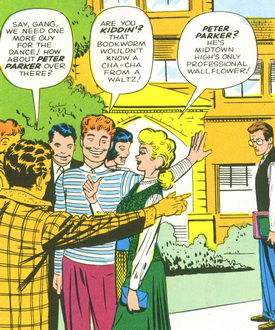 Okay. I have to stop a moment to reflect….who exactly is the NERD in this scene? Peter Parker, the bookworm, or Flash, in the pink pants and striped sweater, talking about the cha-cha and the waltz??
Okay. I have to stop a moment to reflect….who exactly is the NERD in this scene? Peter Parker, the bookworm, or Flash, in the pink pants and striped sweater, talking about the cha-cha and the waltz??
Maybe it’s a “60’s Thing,” but I sometimes notice in these comics that the portrayal of young people is sometimes not very…hip. Or, as my mother used to say, “Hep.” A lot of times, we’ll see teenage boys wearing suits and ties, sometimes even bow-ties! Oh yeah. And hats. Like men in the fifties used to do. When I was a kid and went to church, all the pews had these little clips on the back, so that the gentlemen could clip their hats there during Mass. But as I said, this was when I was a kid, early 1960’s, same time as these comics. But these were grown men going to church, not teenage boys in high school!
I’m getting a bit off topic here I think, because we do not actually see any teenagers wearing hats or bow ties in this story, but Flash’s outfit on page one reminded me of the many instances of fashion faus paux we are likely to see along the way in these early comics. I’ll point them out as we go along, mostly because they are so much fun, and I hope to index the most extreme examples on my Fashion Fun and Foibles page at the top of this blog.
But enough of this getting sidetracked! Let’s get to the story at hand! After the humiliation on page one, we find Peter Parker at home with Uncle Ben and Aunt May, both who clearly adore the boy. Then we see Peter in his science class, where his teacher also clearly believes he has the right stuff. The only way Peter strikes out is socially. He attempts to ask out a girl, but she says, “You’re just not my type… especially when there are dreamboats like Flash Thompson around!”
Grrrrr….I told you. Flash Thompson is going to be a thorn in Peter’s side for quite some time.
“I’LL SHOW THEM!”
Despite the cruel behavior of the other high school kids, Peter still attempts to invite them to the science fair. But once again they simply laugh at him. With a small sob, Peter says “Someday I’ll show them! 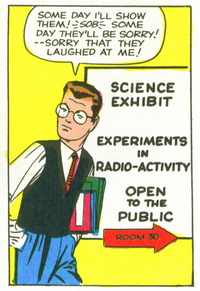 Someday they’ll be sorry!” Sounds like he’s hoping to get his revenge? Kind of makes you wonder, if Peter hadn’t gotten bitten by that radioactive spider and turned into Spider-Man, do you think he may have ended up like one of those kids that’s had just about enough bullying and snaps and brings a gun to school and shoots everyone?
Someday they’ll be sorry!” Sounds like he’s hoping to get his revenge? Kind of makes you wonder, if Peter hadn’t gotten bitten by that radioactive spider and turned into Spider-Man, do you think he may have ended up like one of those kids that’s had just about enough bullying and snaps and brings a gun to school and shoots everyone?
Here at the bottom of page two, that’s what I’m seeing. At least from my 2012 perspective, that’s what I’m thinking. Maybe Stan only meant that Peter dreams of one day becoming a great scientist, discovering or inventing something so fabulous that he becomes rich and famous that then…then all those mean kids from high school will be sorry they ever treated him that way! (Think: the Alan Cumming character in Romy and Michelle’s High School Reunion. What a great character, and what a great movie!) You know, actually, now that I think about it, it’s probably highly unlikely that in 1962 anybody really considered the possibility that a teenager might bring a gun to school to shoot the bullies. Probably not likely in comics. Or in the real world.
Sigh….sometimes it makes you wish we could go back in time, doesn’t it?
But Peter’s “I’ll show them!” comes into play a lot sooner than expected. Because on the very next page, we witness the most famous spider bite in history!! (Most certainly worthy of my double exclamation point.) While the scientists are demonstrating the power of atomic energy, a tiny spider descends into the atomic energy field, lands on Peter and bites him. Ow! Yes, he actually says “Ow!” and immediately notices that he feels “strange” and “different,” as if his “entire body is charged with some sort of fantastic energy!”
On the walk home he quickly discovers he can scale walls, crush steel, walk on wire. To test his new powers, Peter puts on a mask and jumps in the wrestling ring with “Crusher Hogan,” whom, of course, he easily crushes, with “the speed, the agility, the very strength of a giant spider!” (Who knew a giant spider would possess those qualities?)
ED SULLIVAN
After the fight, Peter is approached by a TV producer, who wants to get him on The Ed Sullivan Show. Now, if you were alive in the 1960’s, you know that nothing but nothing beats getting on The Ed Sullivan Show! 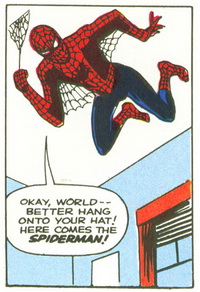 So Peter goes home and devises his costume, and perhaps most importantly of all, creates an apparatus for his wrists which shoot out…something…as if it is a spider’s webbing. He also uses some “strong liquid cement” so that he can pull himself from place to place on these “webs.”
So Peter goes home and devises his costume, and perhaps most importantly of all, creates an apparatus for his wrists which shoot out…something…as if it is a spider’s webbing. He also uses some “strong liquid cement” so that he can pull himself from place to place on these “webs.”
The fact that Super Glue couldn’t actually perform the way Peter needs it to, the way we will see it performing in just a few short pages, is completely beside the point. But then I guess if you feel compelled to make a “Reality Check,” you probably shouldn’t be reading Marvel comics…right? Well, let’s see…I guess we could say that when the glue comes in contact with Peter’s super-atomic-ness, it takes on the very super qualities that he now possesses in his own body. Yeah, I guess that sounds good. Doesn’t it?
I have no problem with super powers. I am willing to suspend my disbelief. But nothing will take me out of a story faster than a grammatical error. Now, if you’re going to hang out here with me in the Marvelous Zone, you’ll quickly find out a few things about me, and one of them is that I happen to be a freakin’ Grammar Nazi.
I know this story right now if very much in its infancy, so maybe Stan had not quite yet decided how he’s going to represent the name of his latest superhero. Of course we know that our radioactive pal Peter Parker takes on the moniker “Spider-Man.” There is a dash in the middle. Now, since comics are written entirely in upper case letters, sometimes it’s hard to know where the upper and lower case letters lie, but of this much we are certain, that there is a dash between the word “spider” and the word “man.” Except on the bottom of page six where Peter exclaims “Here comes the spiderman!” and in fact throughout the rest of this story he is referred to as “spiderman.”
Well, first of all…THE spiderman? I guess “the” got dropped fairly soon. But where is the dash? I know it’s not a big deal, at least it shouldn’t be, since we have a lot more important stuff to do like fighting super-villains and saving the world, but I need 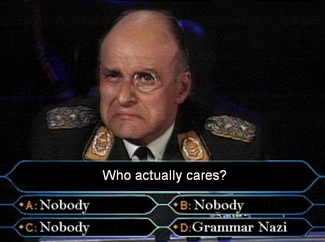 to know where my dashes and capital letters are supposed to be!!
to know where my dashes and capital letters are supposed to be!!
And you know what? Marvel comics doesn’t make that easy, does it? I mean, there is no hard and fast rule about superhero names. So we have Spider-Man, but we also have Iron Man. Two words, no dash. And then there’s Superman…but we won’t go there.
Aaaah! It’s enough to drive a Grammar Nazi crazy!
But let’s leave all this behind to get on with the story.
Spider-Man (or Spiderman, as he’s known here) does indeed appear on TV, and the response is sensational! As Stan puts it, “Peter Parker breathes the first sweet scent of fame and success.” But as he is leaving the TV studio…well, since this is so important, let’s just “play the clip,” as we say in the podcasting business:
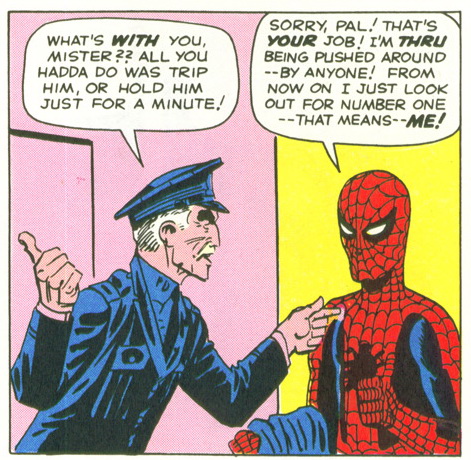
Now, before I read this comic, I had of course seen the Spider-Man movie, the one with Toby McGuire as Peter Parker, and I personally remember this scene being a lot stronger, because in the movie, the wrestling promoter tries to cheat Peter out of his money, and says “I missed the part where that’s my problem.” Then, when the wrestling promoter is robbed and Peter fails to stop the thief, he throws back those exact words at the promoter. So there’s a bit of poetic justice going on there.
Here, we just have Peter being a jerk. Now, I’m not exactly BLAMING him for being a jerk. It’s obvious by what we saw on the introductory pages that he feels, and rightly so, that society has given him a bum rap. Now that he has a taste of power, he’s being selfish with it. He’s letting it go to his head. He finally gets the chance to feel superior to everyone else, and dad gummit! He’s going to enjoy his superiority.
It’s not very mature of him. But I do think it’s understandable, and completely in character for a poor sod like Peter who’s been bullied all his life.
But we do have to give him credit for this much. A few panels later, we see Peter realizing that Aunt May and Uncle Ben are “the only ones who’ve ever been kind to me. I’ll see to it that they’re always happy, but the rest of the world can go hang, for all I care!”
Extremely anti-social, for someone entrusted with so much power. But then, Stan is going to take care of that bad attitude straightaway. I guess it’s a good thing that we only got to know Uncle Ben for a few pages, otherwise I would have found it extremely upsetting when a cop tells Peter that his uncle has been murdered. Of course Peter is extremely upset, and swings into his Spider-Man persona, vowing to “get him” at the old Acme Warehouse. “A killer could hold off an army in that gloomy old place,” Peter declares, “but he won’t hold off…SPIDERMAN!” (No “the,” but no dash, either.)
So Peter tangles with the killer, easily disarms him and knocks him out. The killer’s face is revealed, and at this point Peter realizes that Uncle Ben’s killer is in fact the thief that he chose not to stop when he had the chance, only a few pages earlier.
So. Yes. We do have poetic justice after all. Or rather, poetic injustice? The point is, Peter becomes “aware at last that in this world with great power there must also come– great responsibility!” 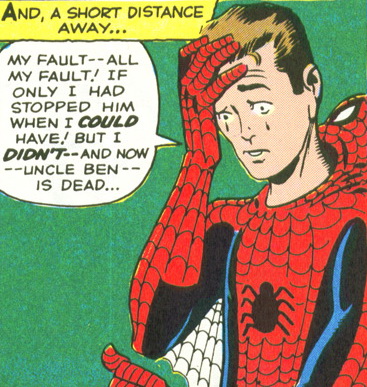 Now, I don’t know a whole lot about comics, but I do believe that this particular line must go down in history as one of the most famous comics quotes of all time. Of course we have Superman’s “It’s a bird! It’s a plane! It’s Superman!” and that’s all very well and good, but it just doesn’t have the emotional punch as this line about power and responsibility. “Avengers, assemble!” Yes, a good call to action. But philosophical observations about power and responsibility trump even that.
Now, I don’t know a whole lot about comics, but I do believe that this particular line must go down in history as one of the most famous comics quotes of all time. Of course we have Superman’s “It’s a bird! It’s a plane! It’s Superman!” and that’s all very well and good, but it just doesn’t have the emotional punch as this line about power and responsibility. “Avengers, assemble!” Yes, a good call to action. But philosophical observations about power and responsibility trump even that.
It’s too bad that Uncle Ben had to die as (somewhat) a result of Peter’s cocky stupidity. But then, his death sets the stage for a maturity and a sense of mission in our new hero. I wonder if fate had not stepped in to instigate the death of one of the only two people in the world that Peter cares about whether or not his Spider-Man persona would have had the opportunity to grow into the great hero he becomes. Would Peter have remained content putting on shows for cash, just to help out his old aunt and uncle?In other words, would he have continued acting as a self-centered, immature BOY? Remember, this story is not about Spider-Boy, it’s about Spider-MAN. Too bad it had to be in the school of hard knocks, but I think Peter has learned his lesson about power and responsibility.
And that is what prepares him to take on the mantle of Spider-MAN.
Of course, if he did not take up that mantle and begin fighting criminals, villains and super-villains, the Marvel world would be a much different place, and we would not have much of a comic-mag to read. So this is one of those bad things that is really a good thing in disguise.
And disguise is what it’s all about in the Spider-Man saga. In the panel above, notice that the bottom headline reads “Who is the Spiderman?” Who, indeed! Spider-Man is one of those super-heroes whose identity shall remain a secret (unlike the Fantastic Four) even from the people he most cares about. I don’t want to get ahead of myself, but I think it’s fair to speculate at this point that the events of this first story are going to provide a myriad of changes in the life of young Peter Parker, changes that have just as much to do with his issues of self-confidence and self-worth as with his ability to swing through the city on self-made “spider webs,” fighting crime. The boy will grow up. We are only beginning to see it here.
A good start.
![]() Next time I meander in the Marvelous Zone, Hulk is banished to outer space, and Rick Jones has a lot to think about. I’ve already mentioned that Hulk is not one of my favorite characters, but will this next story help change my mind? Join me and find out!
Next time I meander in the Marvelous Zone, Hulk is banished to outer space, and Rick Jones has a lot to think about. I’ve already mentioned that Hulk is not one of my favorite characters, but will this next story help change my mind? Join me and find out!
| Want to read this comic on your computer? Marvel has a scan! Want to own this story? Buy the Masterworks! |

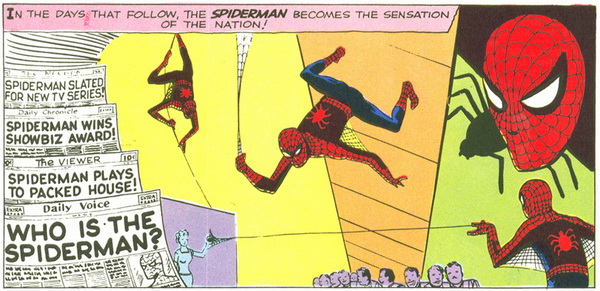














Another great review! The bit about Flash being the real nerd is priceless.
On the cover that’s a lot jumpers Spidey has to save off the rooftops!
Crusher Hogan reminds me of the “Da Crusher” wrestler that Bugs Bunny fought. Also, do ring corner posts ever go that high up?
Like you said, web fluid is really just liquid cement. 🙂
With all the press on spidey. I’m surprised the Daily Bugle hasn’t cashed in yet, but JJJ makes up for it pretty fast in lstter issues.
Is that supposed to be the same cop through the whole story? A captain no less. I think he gets a name years later, but he looks like a mustached Captain Stacy to me.
Ugh, Ditko’s smiles are always creepy. They look like they either have gas, just slow, or had never smiled before in their lives.
The Bell-Ringer and Mummy stories were also both good.
“Crackers and milk! Bless’em–If they only knew!”-Peter Parker
While it may sound funny, Stan was very likely being quite honest when he used the term “long underwear” characters. Super-Hero was not in use much in that period, and I’ve read others in the business using that descriptive word.
It would probably be hard for any of us in the present day to appreciate how different this story was when it first appeared. Costumed heroes all had simple origins and immediately dedicated their life to crime-fighting. Lee and Ditko gave us a teenager who was apart from his peers and did not initially think of using his powers for good. The emotional punch is in Peter Parker facing a cold reality with the death of his uncle, and the understanding that he has to deal with responsibilities.
Lee and Ditko’s Spider-Man would stumble and fall at times, learning as he grew up. Spider-Man was also atypical because he was not a mass of muscles, but a more natural looking build. Over the years Ditko would build him up a little, but in a much more realistic manner then most artists.
While there are a few faults in the story, this was the template for all that came afterward.
Pingback: Megachurch Methods: Mars Hill Global Wakes the Sleeping Giant